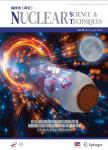Calculation of microscopic nuclear level densities based on covariant density functional theory
作者机构:College of PhysicsJilin UniversityChangchun 130012China Institute of Modern PhysicsChinese Academy of SciencesLanzhou 730000China
出 版 物:《Nuclear Science and Techniques》 (核技术(英文))
年 卷 期:2023年第34卷第9期
页 面:118-127页
核心收录:
学科分类:08[工学] 0827[工学-核科学与技术] 082701[工学-核能科学与工程] 0702[理学-物理学]
基 金:supported by the Natural Science Foundation of Jilin Province(No.20220101017JC) National Natural Science Foundation of China(No.11675063) Key Laboratory of Nuclear Data Foundation(JCKY2020201C157).
主 题:Nuclear level density Covariant density functional theory Combinatorial method
摘 要:In this study,a microscopic method for calculating the nuclear level density(NLD)based on the covariant density functional theory(CDFT)is developed.The particle-hole state density is calculated by a combinatorial method using single-particle level schemes obtained from the CDFT,and the level densities are then obtained by considering collective effects such as vibration and rotation.Our results are compared with those of other NLD models,including phenomenological,microstatisti-cal and nonrelativistic Hartree–Fock–Bogoliubov combinatorial models.This comparison suggests that the general trends among these models are essentially the same,except for some deviations among the different NLD models.In addition,the NLDs obtained using the CDFT combinatorial method with normalization are compared with experimental data,including the observed cumulative number of levels at low excitation energies and the measured NLDs.The CDFT combinatorial method yields results that are in reasonable agreement with the existing experimental data.



